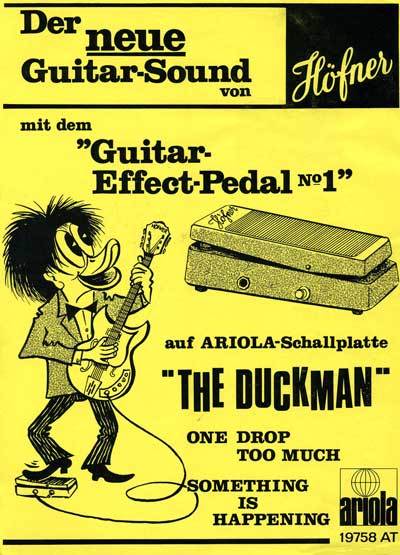
HOFNER-BRANDED EFFECT PEDALS

Hofner began offering active circuit "effects" as an option on many of their archtop and thinline guitars from the mid-1950's onwards. These were developed as a joint project between Walter Hofner and Franz Pix, who was Hofner's supplier of pickups and control panels at that time. They included simple active circuits, treble boost, and tremolo circuits. (See HOFNER ACTIVE ELECTRONICS - FACT FILE)
This facility must have proved popular, because in 1967, Hofner introduced a more extensive range of options, incorporated on new control consoles which allowed up to three effects to be added to the same guitar. Fuzz, Bass Boost, Sound-Mix, and even Wah were available to the Hofner owner, all controllable from his guitar's body top! Furthermore, these options were made available on many of Hofner's expanding bass guitar range. Once again, these instrument-mounted effects appear to have come about because of the close working relationship between Walter Hofner and Franz Pix.
Pedal effects, particularly "Fuzz", began to be produced by other manufacturers from 1966, with the most noteworthy exponent being Jimi Hendrix. In 1967 therefore, Hofner introduced three effect pedals into their catalogue - a Fuzz Tone (No. 540), a Treble Booster (No. 541). and a Bass Booster (No. 542). These pedals were also available with Schaller markings, and therefore it could be concluded that the Hofner-branded pedals were in fact manufactured by the Schaller company.
Shortly after the introduction of the above, in late 1967/early 1968 Hofner continued the tend by offering a much more complex pedal, the Guitar Effect Pedal No 1. Unlike the other single-purpose pedals, this was a foot-operated variable pedal which carried out multiple tasks. These are best listed out below in the wording used in the Hofner marketing material::
-
"Changing as quickly as you like from normal sound to the very sharp treble effects"
-
"An amazing Wah-Wah sound similar to the tone of a muted trumpet"
-
"A growl effect of your guitar chords"
-
"The Far-Eastern sound of a sitar"
-
"An original plug effect for deeper positions (new bass tone)"
-
"By Oscillation of the overtones you may touch a chord without changing the finger position and without touching again the strings.You may allow a third, quint, or octave to higher sound. This is representing a really non-recurring effect that was not known up to now."
A version of the Pedal No 1 which also included Fuzz to the above list appeared a short time later from 1968 onwards - the Guitar Effect Pedal No 1Z
A further development of Pedal No 1 was introduced in 1968. Called appropriately enough the "Guitar Effects Pedal No.2" (and 2Z with Fuzz), this was advertised as having an extended frequency range to that of Pedal No. 1. Otherwise, it would appear to have had the same functions.
By 1971, further pedals had been introduced to the range, including a "Distortion Device" (No. 539), which seems to have been a cheaper version of the Fuzz Tone (No. 540) shown above, and a Tremolo Pedal (No. 544).
In 1976, a phaser pedal was introduced into the Hofner catalogue. This definitely displayed its Schaller pedigree, being almost identical to the equivalentSchaller-badged pedal, but with Hofner badging.
It is difficult now to be 100% positive as to who or which companies were involved in the design and manufacture of the Hofner pedals, particularly as the name of Franz Pix does appear on a diagram for the No 2Z pedal. Most of the diagrams in the Hofner archives are un-named, but there are some Schaller diagrams within the archive. Certainly, it would appear that Schaller were once again heavily involved, as the later Hofner pedals appear almost identical to the Schaller-branded equivalents. Just to confuse things still further, there is a possibility that the contemporary Vox wah pedal could have been used as a pattern for the earlier No1 & No2 Effect Pedal's case design.
Hofner had pedals in their catalogue from 1967 through to the mid-1980's. It is fairly obvious that Schaller were heavily involved, but that does follow the pattern of the close and co-operative relationships that existed throughout the Bavarian guitar industry, particularly those companies that had previously worked together for many years in the Schönbach/Markneukertchin area of Bohemia prior to the 2nd World War.
In 2010, Hofner returned to offering in their catalogue a range of new analogue effects pedals under the Hofner brand-name.
VINTAGE HOFNER WEBSITE FACT FILES
INDEX PAGE
All rights reserved